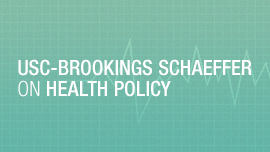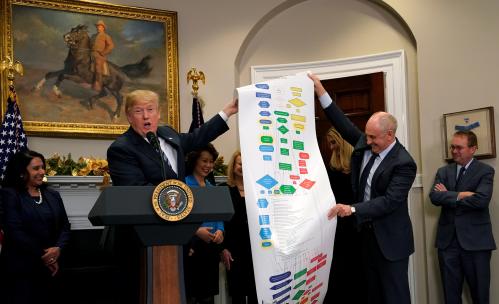This analysis is part of the USC-Brookings Schaeffer Initiative for Health Policy, which is a partnership between the Center for Health Policy at Brookings and the University of Southern California Schaeffer Center for Health Policy & Economics. The Initiative aims to inform the national health care debate with rigorous, evidence-based analysis leading to practical recommendations using the collaborative strengths of USC and Brookings.
Section 1332 of the Affordable Care Act allows states to seek a waiver of various ACA requirements if the state can demonstrate that its proposal would not reduce the number of people covered or the affordability or comprehensiveness of that coverage, or increase federal deficits. For the last several years, the Department of Health and Human Services and the Department of the Treasury have worked to give meaning to this statutory instruction.
A recent guidance document issued in late October by the two agencies represents the latest foray. It claims to make significant new policy, primarily by loosening the standards for comprehensive, affordable coverage. But importantly, the agencies chose to release it as guidance, rather than as a rule subject to the typical notice and comment rulemaking process. There are serious questions about whether the policy articulated in the guidance is a permissible interpretation of the underlying statute, but, at the very least, it is likely invalid for the agency to attempt to make this policy without a full rulemaking process.
Specifically, by releasing the document as guidance, the agencies are implicitly taking the position that it is an “interpretative rule” exempt from the standard rulemaking process under the Administrative Procedure Act (APA). However, the new guidance contains policy that would likely be classified under the APA as a “legislative rule.” As a result, the agencies likely cannot adopt these changes without notice and comment rulemaking, and the guidance may be invalid. Claims that the guidance is procedurally invalid open up potential new avenues for litigation surrounding section 1332 in general and could also become relevant to challenges regarding an approved waiver.
Defining “interpretative rule” vs. “legislative rule” under the Administrative Procedure Act
Since 1946, the Administrative Procedure Act has outlined the process agencies must follow when promulgating rules. The statute requires a standard notice and comment process for all policymaking, but exempts “interpretative” rules from these procedures.[1] Thus, courts have come to distinguish between “legislative” or “substantive” rules that do require notice and comment under the APA, and interpretative rules that do not.
It is important to emphasize that an agency action described as interpreting language that appears elsewhere is not necessarily an “interpretative rule.” Indeed, much of what agencies do in their traditional notice and comment rulemaking is focused on interpreting the statutes under their jurisdiction. As just one example, in a sweeping rulemaking process that began in 2009, the EPA concluded it had authority to and would begin regulating greenhouse gases. To accomplish that major policy change, the EPA was, formally, interpreting the term “air pollutant” in the Clean Air Act to include carbon dioxide. But a court would be quite unlikely to conclude that an agency could begin to regulate a major segment of the U.S. economy (and implement the result of a years-long legal battle) with a simple guidance document. Significant actions like this will require notice and comment under the APA.
Instead, courts have construed the term “interpretative rule” to mean something narrower.
In determining whether a rule is interpretative, courts generally start with the formulation that legislative rules have the “force and effect of law” while interpretative rules “advise the public of the agency’s construction of the statutes and rules which it administers.”[2] To give meaning to this distinction, courts have considered a number of factors:
- Substantive change: A common thread in many cases is an attempt to understand whether the guidance is a meaningful change from the statute or existing legislative rule. Courts have looked to whether the guidance “effects a substantive regulatory change to the statutory or regulatory regime,”[3] or whether it “expand[s] the footprint of a regulation.”[4]
- Nature of the interpretative leap: How significant is the agency’s interpretative leap? As one court explained, “the distinction between an interpretative rule and substantive rule … likely turns on how tightly the agency’s interpretation is drawn linguistically from the actual language of the statute.”[5] The more ambiguous the term the agency purports to interpret, and the more convoluted the agency’s interpretation is, the less likely the guidance is to be considered interpretative.
- Legislative basis: Courts have looked to whether, in the absence of the supposedly interpretative rule, there would be an “adequate legislative basis”[6] for the agency’s future action. That is, if the agency had never issued their guidance, would they still have grounding in the statute or in a legislative rule for doing whatever it is the guidance promises they will do? If not, then the guidance will not be considered interpretative.
- Rights and duties: Another formulation that courts have used is whether the guidance “imposes new rights or duties”[7] that would not otherwise exist.
Recent guidance on the ACA’s Section 1332 State Innovation Waivers is only valid if the waiver is an interpretative rule
Section 1332 of the ACA allows the federal government to grant states a waiver of various ACA requirements if the state can show they have an alternative plan that “will provide coverage that is at least as comprehensive…, will provide coverage and cost-sharing protections against excessive out-of-pocket spending that are at least as affordable…, will provide coverage to at least a comparable number of its residents…, [and] will not increase the federal deficit.”[8]
Comprehensiveness, affordability, coverage, and deficit neutrality are broad concepts. Since the passage of the ACA, stakeholders have wondered how to determine if a state plan satisfies these guardrails. In 2015, the federal government released a guidance document that explained the approach it would take in evaluating a state’s proposal.[9]
In October 2018, the government released new guidance that makes significant policy changes and expressly “supersedes” the 2015 guidance.[10] The primary thrust of the 2018 guidance is to weaken the comprehensiveness, affordability, and coverage guardrails, i.e., it states that the federal government would now deem a state plan to satisfy the comprehensiveness, affordability, and coverage tests that would have failed under the 2015 approach. But because neither guidance document was adopted using the notice and comment procedures in the APA, the guidance is only valid if it can be considered an interpretative rule under the APA.[11]
The 2018 guidance does not appear to be an interpretative rule
Much of the 2018 guidance does not seem consistent with the standards courts have articulated for an interpretative rule. The guidance makes substantial new policy that is a departure from the underlying statute, and thus should not be considered a valid interpretative rule.
Much of the 2018 guidance does not seem consistent with the standards courts have articulated for an interpretative rule.
Start by considering the agencies’ own description of the 2018 guidance document. “This guidance,” the agencies write, “intends to expand state flexibility.”[12] Elsewhere, the document explains that the guidance “aims to lower barriers” and that the agencies “are seeking to reduce burdens.” (Contrast that with parallel language in the 2015 guidance, which explains that the document “provides additional information about” the 1332 guardrails.) While a court will look deeper than this sort of precatory text, it is illuminating that the agencies say they expressly intended to expand the scope of 1332 waivers—and difficult to argue that they could satisfy that objective without affecting the rights and duties of third parties or “expanding the footprint” of the regulatory scheme.
The “Made Available” test
The most impactful policy in the new guidance affects the affordability and comprehensiveness guardrails. The 2015 guidance had explained that affordability and comprehensiveness would be measured by looking at what sort of health insurance coverage individuals would actually become enrolled in under the state’s proposed plan. The agencies articulated that this was a straightforward interpretation of the language in the statute, which directs the agencies to consider whether the state plan “will provide coverage” that is comprehensive and affordable. The 2018 guidance constructs a novel analysis—asking not what sort of coverage people will actually have, but rather what coverage is made “available” to people. Under the 2018 guidance, a state’s plan will be considered to satisfy the comprehensiveness and affordability guardrails even if residents will have less comprehensive or less affordable coverage compared to the status quo, as long as more comprehensive and more affordable coverage exist for individuals to hypothetically become enrolled in.
This new test is a significant departure from the statutory text. The agencies are reading the phrase “will provide coverage” to mean “will make available coverage.” If a court is asked to consider whether this is a valid interpretative rule, it will, as noted above, look to “how tightly the agency’s interpretation is drawn linguistically from the actual language of the statute.” It’s difficult to believe that the invention of the “made available” concept could survive this analysis. Put another way, one who is in fact provided comprehensive coverage is in a very different position from one who merely has that coverage made available to them—and so the guidance represents a major change from what the plain text of the statute more clearly envisions.
Defining coverage
The 2018 guidance also has a significant impact on a third 1332 guardrail: coverage. To analyze whether their plan meets this guardrail, states must quantify the number of people projected to have health coverage under the waiver. But to do so, states need to know what sort of health care arrangements “count” as coverage within the meaning of 1332. In the new guidance, the agencies purport to adopt a definition that classifies many kinds of health benefits as coverage—even if the benefit is limited and does not provide meaningful financial protection from medical costs. Specifically, the agencies explain that “in line with the Administration’s priority favoring private coverage, including [Association Health Plans] and [Short-Term Limited-Duration Insurance] plans,” they are broadening the definition of coverage to include those benefits. They accomplish this by defining coverage under 1332 as anything that would count as “health insurance coverage” under a 1997 regulation associated with implementation of HIPAA, which was intended to cast a wide net for regulation by federal and state law.[13]
As above, this change to the coverage guardrail is a significant interpretative leave from the plain text of the statute, and it inflicts a major substantive change to the program laid out in law. The statutory guardrails are structured to ensure that a state’s proposed waiver plan will result in outcomes that are broadly similar to the outcomes under the ACA. But allowing these sorts of plans—especially short-term limited-duration benefits—to count as “coverage” erodes that vision. The agencies are reaching for an unrelated cross reference to implement a meaningful new policy. Further, the fact that it is definitional does not render it an interpretative rule—the agencies explain that the change is intended to make short-term and association-based plans “count” under 1332, and that sort of significant new policy is exactly the type of change that makes a rule legislative rather than interpretative.
Additional changes that disqualify the guidance from being an interpretive rule
The guidance makes additional changes that may have less sweeping policy impacts but raise the same sorts of questions:
- The guidance concludes that for purposes of meeting the coverage guardrail, it is permissible for a state plan to cause a temporary reduction in the number of people covered, if that is made up over time. There is no statutory basis for this sort of exception, and it implicates the same kinds of concerns about the nature of the agencies’ interpretative leap.
- The agencies introduce the concept of the “magnitude” of changes in affordability, explaining that a waiver that reduces overall affordability could still be approved if the changes do not make people “substantially worse off.” In addition to being extremely vague, this new policy attempts to expand the agencies’ authority beyond what is conferred to them in statute, which cannot be permitted in an interpretative rule.
- The guidance also addresses the statutory requirement that a state applying for a waiver have enacted a “State law that provides for State actions under a waiver under this section.” The guidance explains that the agencies may consider a state to have met this requirement in situations where the state has enacted only a general law related to ACA implementation, not anything specific to the proposed waiver. As above, the agencies are purporting to give themselves new authority to approve waivers, beyond what is available in statute, and an interpretative rule cannot accomplish that result.
Differences between the 2015 guidance and the 2018 guidance
Whether or not the 2018 guidance is a valid interpretative rule does not turn on the validity of the prior guidance, issued in 2015. Nonetheless, it is instructive to contrast the two documents. The 2015 guidance did introduce some vocabulary that does not expressly appear in the text of section 1332. For example, it explained that the agencies would consider the impact of the waiver on specific vulnerable groups, and that the analysis of comprehensiveness would be rooted in the ten categories of essential health benefits defined elsewhere in the ACA. But these sorts of explanations are much more clearly attempts to “advise the public of the agency’s construction” of section 1332. Critically, section 1332 provides that the Secretaries of Health and Human Services and the Treasury “may” approve waivers that satisfy the guardrails, but does not obligate them to do so. Therefore, to the extent the 2015 guidance explained how the agencies would use the discretion that is clearly granted to them in statute, they were simply offering the public information. Put another way, there is a straightforward “legislative basis” for the agencies to consider these factors, because the statute clearly provides the agencies with the discretion to deny waivers. The 2018 guidance, on the other hand, purports to allow the agencies to approve waivers that are not contemplated by the statute. That kind of action implicates the factors courts looks to in defining a legislative rule: it does not have an existing legislative basis and it “expands the footprint” of the statutory scheme.
Implications of an invalid interpretative rule
If the 2018 guidance is in fact a legislative, rather than interpretative, rule, then the agencies’ attempt to adopt it without notice and comment is impermissible, and that may have significant implications for future litigation.
First, it is important to acknowledge that the analysis of whether a given policy is a valid interpretative rule can quickly start to converge with the analysis of whether that policy is permissible under the statute at all. As noted above, the bigger the interpretative leap being taken by the agency, the more likely a rule is to be legislative.
It’s also very possible, however, that the leap may be so large it cannot be sustained under the statute at all. Similarly, the conclusion that a policy “expands the footprint” of the statutory scheme, imposes new “rights and duties,” or requires a “legislative basis” raises questions about whether that action is permissible under the statute. Thus, there is not a sharp line between procedural objections to the guidance, on the grounds that is should have been adopted using notice and comment, and substantive objections that it should not have been adopted at all. And, indeed, many of the factors suggesting the 132 guidance is not an interpretative rule also suggest that it is simply not a permissible interpretation of the Affordable Care Act.
If the 2018 guidance is in fact a legislative, rather than interpretative, rule, then the agencies’ attempt to adopt it without notice and comment is impermissible, and that may have significant implications for future litigation.
However, the use of a potentially invalid interpretative rule may create distinct possibilities for challenging the guidance, separate from any challenge to the underlying content. Entities that can plausibly assert that they will bear costs now, prior to any waiver approval, because of the position taken in this guidance may seek to enjoin its application. For example, a city or county in a state considering a 1332 waiver may be able to make such an argument. Or, to the extent the guidance affects the way a state is required to submit materials to the agencies for a 1332 waiver proposal—even if the state’s proposal would not “invoke” the policy changes announced in the guidance—there may be circumstances where a state could make such an argument.
The existence of the 2018 guidance enhances the ability of affected parties to argue that the dispute is ripe for litigation, because the agencies have clearly articulated the action they intend to take in a way that a court can meaningfully adjudicate. The agencies’ recent announcement that they will release “templates” for states to use in submitting waivers[14] further supports this line of reasoning, as it shows the agencies continuing down a path and imposing burdens on entities involved in the 1332 process. Enjoining the guidance would not immediately affect whether a particular waiver could be approved, but it could limit the agencies’ ability to apply the novel criteria that appear in the guidance.
Additionally, potential procedural issues associated with this guidance could become relevant in litigation after a waiver was approved. As just one example, to the extent the agencies rely on policies articulated in the guidance, the court could declare the guidance invalid and remand a waiver to the agency for additional consideration. While the details of any such challenge will depend on the particular waiver approved and the nature of the agency action, procedural deficiencies with this guidance would strip the agency of any deference and make it more likely that objections to a waiver approval would succeed.
[1] 5 U.S.C. § 533 (b). Note that agencies often describe their actions as “guidance” or “subregulatory guidance.” Guidance is not a category recognized under the APA; the APA’s formal rulemaking processes apply to all agency policymaking activity unless a specific exception applies. Specific exceptions are available for military functions, agency management (personnel, property, etc), and “interpretative rules, general statements of policy, or rules of agency organization, procedure, or practice.” The exception for interpretative rules is the only plausible pathway for the kind of policy being made in the recent 1332 guidance. Thus, regardless of how the agencies label the document, they must have implicitly concluded it is an interpretative rule.
[2] See, e.g., Perez v. Mortgage Bankers Ass’n, 575 U.S. ___ (2015).
[3] Elec. Privacy Info. Ctr. v. U.S. Dep’t of Homeland Sec., 653 F.3d 1, 6–7 (D.C.Cir.2011). See also Mendoza v. Perez, 754 F.3d 1002, 1021 (D.C. Cir.) (asking if the interpretative rule “effects a substantive change in existing law or policy”).
[4] Iowa League of Cities v. E.P.A., 711 F.3d 844, 873 (8th Cir. 2013).
[5] Syncor Int’l Corp. v. Shalala, 127 F.3d 90, 94 (D.C. Cir. 1997).
[6] American Mining Congress v. Mine Safety & Health Administration, 995 F.2d 1106 (D.C. Cir. 1993)
[7] Jerri’s Ceramic Arts, Inc. v. Consumer Prod. Safety Comm’n, 874 F.2d 205, 207 (4th Cir. 1989).
[8] 42 U.S.C. § 18052.
[9] Centers for Medicare & Medicaid Services (CMS), HHS; Department of the Treasury. 2015. “Waivers for State Innovation.” Last modified December 16, 2015. 80. Fed. Reg. 78131. https://www.federalregister.gov/documents/2015/12/16/2015-31563/waivers-for-state-innovation
[10] Centers for Medicare & Medicaid Services (CMS), HHS; Department of the Treasury. 2018. “State Relief and Empowerment Waivers.” 83 Fed. Reg. 53575. Last modified October 24, 2018. https://www.federalregister.gov/documents/2018/10/24/2018-23182/state-relief-and-empowerment-waivers
[11] From 1997 to 2015, a line of cases developed in the D.C. Circuit holding that once an agency had released an interpretative rule, future changes to that interpretation often require notice and comment. Thus, under that line of reasoning, the 2018 guidance would be impermissible without notice and comment simply because it was a major change. However, in March 2015 the Supreme Court unanimously struck down the D.C. Circuit’s approach and held that interpretative rules could be changed with other interpretative rules that did not require notice and comment. Perez v. Mortgage Bankers Ass’n, 575 U.S. ___ (2015). Therefore, the question is not whether the 2018 guidance is a change from the 2015 guidance, but rather whether the 2018 guidance is itself an interpretative rule.
[12] Centers for Medicare & Medicaid Services (CMS), HHS; Department of the Treasury. 2018. “State Relief and Empowerment Waivers.” 83 Fed. Reg. 53575. Last modified October 24, 2018. https://www.federalregister.gov/documents/2018/10/24/2018-23182/state-relief-and-empowerment-waivers
[13] This definition was first adopted in 1997. 62 Fed. Reg. 16894. It was modified to expressly include short-term limited-duration coverage in 2004. 69 Fed. Reg. 78719.
[14] Yochelson, M. (2018). “Guidance coming Thursday for states that want to tweak Obamacare.” Bloomberg Law. November 27, 2018. https://news.bloomberglaw.com/health-law-and-business/guidance-coming-thursday-for-states-that-want-to-tweak-obamacare.
The Brookings Institution is committed to quality, independence, and impact.
We are supported by a diverse array of funders. In line with our values and policies, each Brookings publication represents the sole views of its author(s).







Commentary
The Trump administration side-stepped rulemaking processes on the ACA’s State Innovation Waivers—and it could make their new section 1332 guidance invalid
November 28, 2018